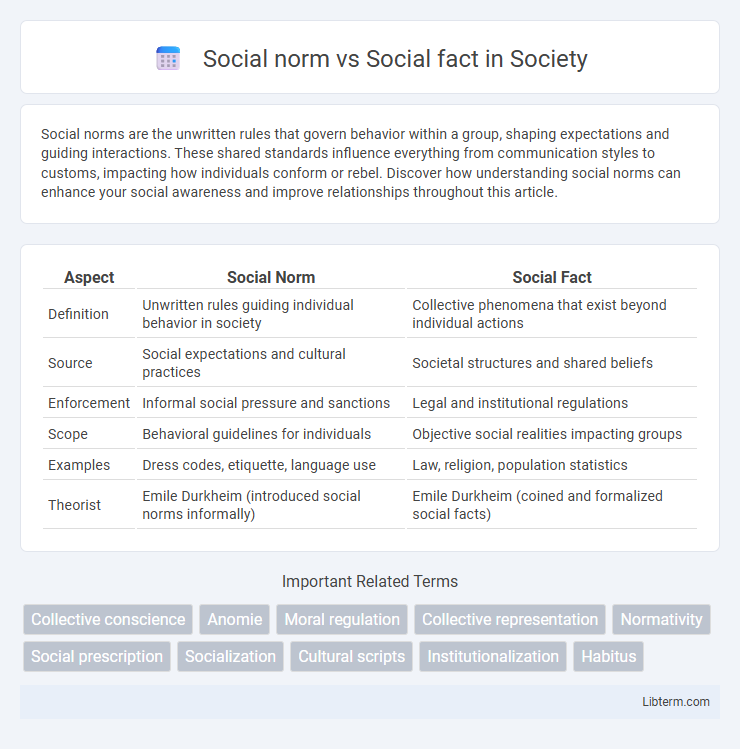Social norms are the unwritten rules that govern behavior within a group, shaping expectations and guiding interactions. These shared standards influence everything from communication styles to customs, impacting how individuals conform or rebel. Discover how understanding social norms can enhance your social awareness and improve relationships throughout this article.
Table of Comparison
| Aspect | Social Norm | Social Fact |
|---|---|---|
| Definition | Unwritten rules guiding individual behavior in society | Collective phenomena that exist beyond individual actions |
| Source | Social expectations and cultural practices | Societal structures and shared beliefs |
| Enforcement | Informal social pressure and sanctions | Legal and institutional regulations |
| Scope | Behavioral guidelines for individuals | Objective social realities impacting groups |
| Examples | Dress codes, etiquette, language use | Law, religion, population statistics |
| Theorist | Emile Durkheim (introduced social norms informally) | Emile Durkheim (coined and formalized social facts) |
Understanding Social Norms: Definition and Examples
Social norms are unwritten rules that govern behavior within a society, guiding individuals on acceptable and expected actions. Examples include shaking hands when greeting or queuing in public spaces, which maintain social order through shared understanding. Unlike social facts, which are external and coercive forces, social norms rely on collective agreement and influence through social approval and sanctions.
Defining Social Facts: Durkheim’s Perspective
Social facts, as defined by Emile Durkheim, are collective ways of acting, thinking, and feeling that exist outside individual consciousness and exert coercive power over individuals. These social facts encompass norms, values, and structures that shape societal behavior and maintain social order independently of personal choices. Unlike social norms, which are specific rules of conduct, social facts represent broader, objective realities fundamental to the functioning of society.
Historical Evolution of Social Norms and Facts
Social norms originate from collective behaviors that evolve over time, shaped by cultural practices and societal changes, while social facts represent external, coercive forces established by institutions and historic events. Emile Durkheim emphasized social facts as objective realities influencing individual actions, contrasting with the fluid and adaptive nature of social norms shaped by historical contexts. The historical evolution demonstrates how norms adapt to shifts in economic, political, and technological landscapes, whereas social facts maintain societal order through persistent rules and legal frameworks.
Key Differences Between Social Norms and Social Facts
Social norms are unwritten rules guiding individual behavior within a group, emphasizing expectations and social roles, while social facts are external, coercive forces existing independently of individual actions, often documented in laws or institutions. Social norms shape everyday interactions through shared values and customs, whereas social facts influence society on a structural level, such as legal systems, economic practices, and cultural traditions. The key difference lies in social norms being informal and mutable, contrasted with social facts' objective and enduring nature impacting collective social life.
Functions of Social Norms in Society
Social norms regulate behavior by establishing shared expectations and promoting social order, facilitating cooperation within communities. They function as informal rules that guide individual actions, ensuring predictability and stability in social interactions. By reinforcing collective values, social norms contribute to social cohesion and help maintain societal equilibrium.
The Role of Social Facts in Shaping Behavior
Social facts, as defined by Emile Durkheim, represent collective norms, values, and structures that exert external influence on individual behavior, shaping actions beyond personal preferences. These social facts function as binding forces within society, enforcing conformity through expectations and sanctions that maintain social order. Understanding this dynamic reveals how deeply ingrained social facts dictate behavioral patterns, distinguishing them from more fluid social norms.
Social Norms in Daily Life: Case Studies
Social norms in daily life shape behavior by establishing unwritten rules that govern interactions within communities, influencing everything from etiquette to workplace conduct. Case studies reveal how these norms vary across cultures yet consistently maintain social order, such as the expectation of queueing in Western societies versus communal sharing practices in indigenous groups. Understanding these patterns aids in addressing social conflicts and fostering cooperation in diverse environments.
Social Facts and Collective Consciousness
Social facts are external social forces that shape individual behavior, existing independently of personal consciousness and maintaining societal order. These facts are manifestations of collective consciousness, representing shared beliefs, values, and norms that bind members of society together. Emile Durkheim emphasized that social facts exert coercive power, compelling individuals to conform for social cohesion.
Impact of Social Norms and Facts on Social Change
Social norms shape daily behavior by establishing expected conduct, directly influencing social change through gradual shifts in collective attitudes and practices. Social facts, as external, coercive societal forces such as laws and institutions, drive broader structural transformations by enforcing conformity and legitimizing new standards. The interplay between social norms and social facts accelerates social change by blending individual-level adaptations with systemic modifications.
Relevance Today: Navigating Modern Social Expectations
Social norms shape individual behavior through unwritten rules that govern daily interactions, while social facts represent broader societal forces that exist independently of individuals. In today's digital age, understanding the distinction helps navigate complex social expectations driven by online communities and cultural shifts. Recognizing social facts allows policymakers and sociologists to address systemic issues, whereas awareness of social norms guides personal conduct and social cohesion.
Social norm Infographic

 libterm.com
libterm.com